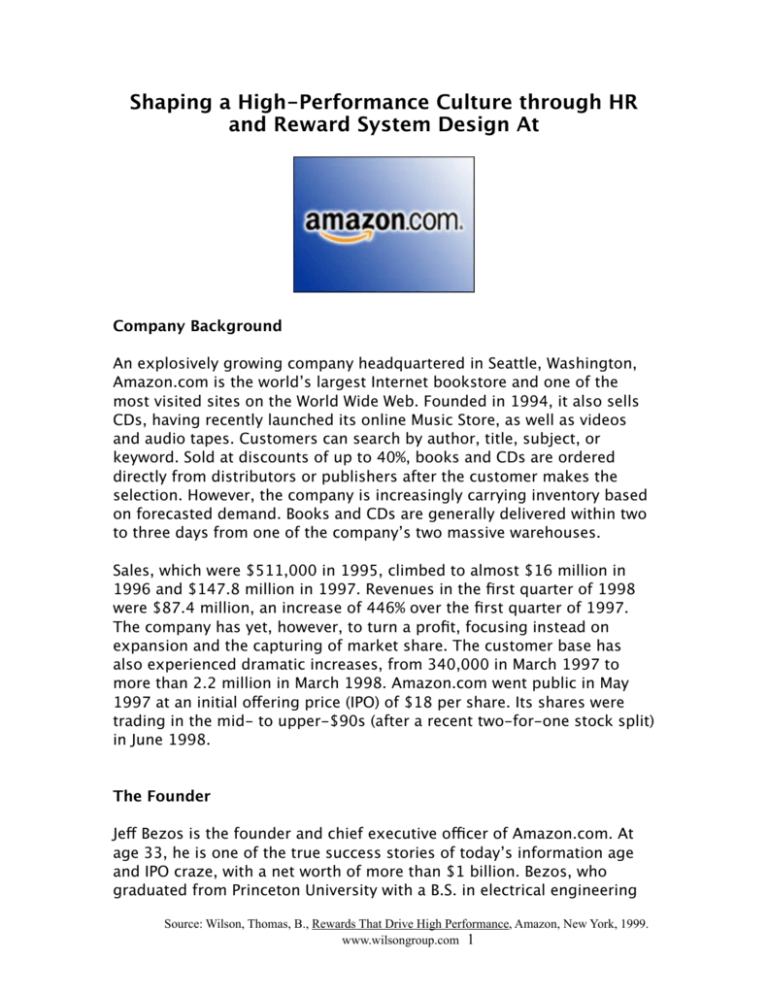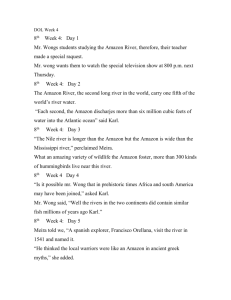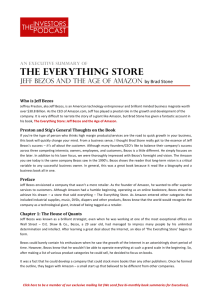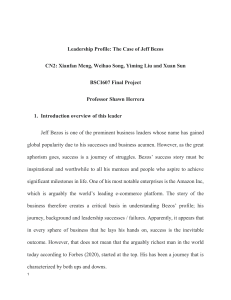Amazon.com - Wilson Group
advertisement

Shaping a High-Performance Culture through HR and Reward System Design At Company Background An explosively growing company headquartered in Seattle, Washington, Amazon.com is the world’s largest Internet bookstore and one of the most visited sites on the World Wide Web. Founded in 1994, it also sells CDs, having recently launched its online Music Store, as well as videos and audio tapes. Customers can search by author, title, subject, or keyword. Sold at discounts of up to 40%, books and CDs are ordered directly from distributors or publishers after the customer makes the selection. However, the company is increasingly carrying inventory based on forecasted demand. Books and CDs are generally delivered within two to three days from one of the company’s two massive warehouses. Sales, which were $511,000 in 1995, climbed to almost $16 million in 1996 and $147.8 million in 1997. Revenues in the first quarter of 1998 were $87.4 million, an increase of 446% over the first quarter of 1997. The company has yet, however, to turn a profit, focusing instead on expansion and the capturing of market share. The customer base has also experienced dramatic increases, from 340,000 in March 1997 to more than 2.2 million in March 1998. Amazon.com went public in May 1997 at an initial offering price (IPO) of $18 per share. Its shares were trading in the mid- to upper-$90s (after a recent two-for-one stock split) in June 1998. The Founder Jeff Bezos is the founder and chief executive officer of Amazon.com. At age 33, he is one of the true success stories of today’s information age and IPO craze, with a net worth of more than $1 billion. Bezos, who graduated from Princeton University with a B.S. in electrical engineering Source: Wilson, Thomas, B., Rewards That Drive High Performance, Amazon, New York, 1999. www.wilsongroup.com 1 and computer science, always wanted to be an entrepreneur. He realized the Internet was his path in 1994, while he was working at D. E. Shaw on Wall Street and learned that usage of the World Wide Web was growing at 230% a year. He realized that this was faster than anything he had ever seen, so he decided to try to find a business plan that would make sense for the Web. Seeing that you can build a unique bookstore online, as there is no way to have 2.5 million titles in a physical world bookstore, Amazon.com was born. The Culture Bezos has worked hard from day one of the company to build a strong and powerful culture at Amazon.com. It is a frugal culture, given the intensely competitive nature of the business and the resultant low margins. To this day, all desks within the company are made of recycled wooden doors, phone books serve as computer monitor stands, and plastic milk crates serve as filing cabinets. This allows the company to invest more in its growth and continue to be able to scale the industry rapidly, as opposed to investing in its physical assets. It is a culture characterized by intense and hard work. Rapid growth, stiff competition from Barnes & Noble and Borders, international expansion, and entree’s into new markets create a supercharged environment where employees want to win and are willing to go to great lengths to ensure that happens. The culture is also characterized by a balanced short- and longer-term orientation, in which Bezos sets the trend. Wall Street, typically focused on short-term profitability, is enamored with this company that is looking to revolutionize Internet commerce as a much longer-term perspective. However, Bezos also knows that long-run success is only possible by executing flawlessly in the short-term. Thus, he demands both in the organization—delivering short-term results that will help guarantee long-range success. It is a culture that is passionate about what it does—transforming the way in which people buy products over the Internet. Bezos does not want a culture at Amazon.com that will appeal to everyone—rather, he wants it to be a culture that will appeal to those who truly want to make a difference and who are willing to do what it takes to make that kind of difference. The Employees Source: Wilson, Thomas, B., Rewards That Drive High Performance, Amazon, New York, 1999. www.wilsongroup.com 2 Along with spectacular revenue growth has come a rapid expansion of the employee population, rising from approximately 150 at the end of 1996 to more than 600 at the end of 1997 and almost 900 in mid-1998. What has remained constant, however, is the quality of people that the company hires. Amazon.com has one of the brightest workforces. While the company does not screen people out due to their Scholastic Aptitude Test (SAT) scores, it does ask for them in interviews and ends up hiring people who were top graduates at Princeton, Dartmouth, Harvard, Stanford, Berkeley, and other top institutions. It is also hiring top up-and-coming talent from such companies as Microsoft and Wal-Mart—all organizations that know something about high growth. The average age of the workforce is 28, not unlike many other highly successful Silicon Valley, high tech start-ups. It is a passionate, energetic, highly motivated collection of individuals who are out to change Internet commerce. While the average age of the workforce is relatively young, Bezos knew that to scale a company as rapidly as Amazon.com, he needed a senior management team that had experience building a rapidly growing organization. Executives and senior managers come from organizations such as Wal-Mart, Microsoft, Avid Technology, Apple Computer, Cisco Systems, and Sun Microsystems. The Reward System The reward system at Amazon.com is definitely aligned with its business strategy, employee base, culture, and position in its growth cycle. Amazon.com pays base salaries that are slightly less than competitive on average—competitive at the lowest levels of the organization and then increasingly behind the market as employees move up the organization. The company also has no short-term incentive system, so total cash compensation is also slightly lower than the competitive marketplace. This cash compensation strategy fits well with the competitive business environment in which it operates (relatively low margins and high levels of competition driving the need to capture market share in order to best compete). The strategy also fits well with the growth cycle position of a company (high growth needing cash to finance its expansion) and with its culture of wanting to be long-run focused. Source: Wilson, Thomas, B., Rewards That Drive High Performance, Amazon, New York, 1999. www.wilsongroup.com 3 When Bezos founded the company in 1994, he believed that to be successful in the longer term, all employees had to retain “ownership” in the organization. As a result, every employee in the company, from executives down to the hundreds of employees working in the warehouse operations, receives new-hire stock options at highly competitive levels. In slightly more than a year after going public, with the stock having climbed to nearly $200 a share (adjusting for the stock split), many employees have accumulated substantial option gains. Even some $18,000-per-year warehouse operations workers have paper gains of more than $50,000. This option strategy has allowed Amazon.com to attract and retain the kind of workforce that it wants and needs to grow, to conserve cash for expansion, and to allow all employees to have a key stake in the long-term success of the company. There are no perquisites within the company, reflecting its egalitarian culture. Executives’ offices are furnished the same way all others within the company are (e.g., desks made of recycled doors). Before acquiring additional space recently, many offices were doubled-or tripled-up, and Bezos told the executive officers that they would not be exempt from this change as well. The benefit plans are typical of most start-up and highgrowth organizations— covering the major areas of need but not fully comprehensive. There is also significant cost sharing in the medical arena, again to conserve cash for expansion. The Reward System/Employee Linkage The reward system is unmistakably linked to the company strategy, business environment, culture, and position within its growth cycle. How does it link to employee needs and expectations? The company is out to hire a certain profile of individual—aggressive, bright, forward thinking, someone out to make a real difference and invested in the long-term success of Amazon.com. It is able to get and keep this kind of individual through the design of its reward system. Relatively low base salaries, no short-term incentives, and generous levels of stock options attract people who are hungry, willing to trade short-term economics for the potential of far greater long-term gains, and unafraid to work incredibly hard to make success a reality. Conversely, the compensation system also acts as a highly effective screening tool for people who do not have the profile that the company is looking for. Those unwilling or unable to take a risk, to trade off shortterm for long-term potential, and to live in an egalitarian, no-perquisites Source: Wilson, Thomas, B., Rewards That Drive High Performance, Amazon, New York, 1999. www.wilsongroup.com 4 organization are going to select out due to the structure of the reward system. What the Future Holds Amazon.com has already begun looking at what the future holds for its reward systems. What is clear, and what will not change, is the type of people that the company wants to attract and retain. What will need to change, however, is the specific reward system mix, and undoubtedly the amount and types of components in the reward system. Given the explosive employee growth, stock option dilution must be considered. Given the necessity of attracting a diverse workforce, benefit strategies will have to be looked at. Given the competitive pressures inherent in the labor market, greater pressure to be competitive on cash components will arise. What is gratifying to see, however, is that the company is proactively considering these areas and not waiting until an issue or crisis arises. Will things need to change? Certainly, however, one can be assured that the reward system at Amazon.com will continue to be linked to critical strategies, the culture, and the desire to attract and retain exceptional talent. Source: Wilson, Thomas, B., Rewards That Drive High Performance, Amazon, New York, 1999. www.wilsongroup.com 5










